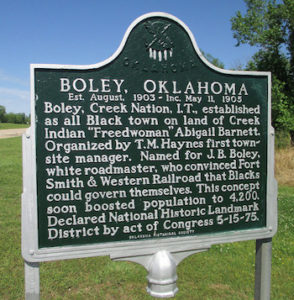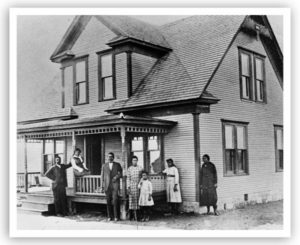
Boley, OK, historic marker
*On this date, in 1904, the Black Town of Boley, Oklahoma, was formally established.
Boley is located in Okfuskee County in Central Oklahoma. The town is of national historical significance because it is representative of the many Blacks Settlements that migrated from the South to northern and Western communities after slavery. Blacks in Boley were hopeful of escaping oppression and making new lives around the turn of the twentieth century. T. M Haynes founded Boley in 1903 in Creek Indian Territory. Railroad officials Lake Moore and J. B. Boley, a white man, contended that Black people could govern themselves and that a Black town should be established along with the Fort Smith and Western Railroad.
The town was incorporated in 1905 as Boley, Creek Nation, Indian Territory. The name was changed to Boley, Oklahoma when the State of Oklahoma was formed in 1907. Boley began on 160 acres of land belonging to Abigail Burnett McCormick. She had inherited the land from the government as the daughter of James Burnett, a Creek Freedman. Haynes publicly invited Blacks to come and settle there and served as the town’s first mayor. Many of the first families became the town's leading citizens, including the Barnetts, Walkers, Grayson, Johnson, and Wilcotts.
After this dates 1904 formal opening, Booker T Washington declared that Boley was “The most enterprising, and in many ways the most interesting of the Negro towns in the U. S.” In 1911, the town had a population of 4,000. In their heyday, Boley had five grocery stores, five hotels, seven restaurants, four cotton gins, three drug stores, one jewelry store, four department stores, two livery stables, two insurance agencies, one undertaking establishment, one lumber yard, two photographers, and an ice plant. Additionally, Boley was known as having the first Black-owned electric company and one of the first black-owned banks.
Boley's early social institutions and public buildings included many churches and schools. This included a training school for Negro boys. Boley was also home to a Masonic Temple, where all Black Masons in the state made a yearly pilgrimage. The Eastern Star and other fraternal orders regularly visited. The Great Depression in the late 1920s to mid-1930s was difficult for Boley. Many residents moved away, and the migration of new residents came to a standstill. The Depression dealt Boley a blow that took a long time to recover.

On November 22, 1932, Pretty Boy Floyd's gang members tried to rob the Farmers & Merchants Bank. The robbers, two white and one Black killed the bank's president, D. J. Turner. Officers and vigilantes killed them during their escape. Currently, Boley offers opportunities and challenges as it did almost 100 years ago, with a population of 748. Its businesses include a manufacturing company, a funeral home, three boarding houses, two gas stations, two grocery stores, one hardware store, a community center, a swimming pool, six churches, an elementary school, a high school, and a town hall.
In recent years, Boley has hosted the Annual Boley Rodeo, which started in 1961. Very popular, the event usually occurs on or near Memorial Day weekend. Boley also holds an Annual Founder's Day Celebration in September, and its Chamber of Commerce also holds a banquet that has featured Congressmen and University Presidents as speakers.
The Boley High School Bears basketball team also won 4 State Championships during the 1970s. Boley, OK, is on Hwy 62, sixty-eight miles southwest of Tulsa and sixty-seven miles east of Oklahoma City. In the 2016 presidential election, the city gave over 78% of the vote to the Democratic Party candidate.
The Encyclopedia of African American Heritage
by Susan Altman
Copyright 1997, Facts on File, Inc. New York
ISBN 0-8160-3289-0